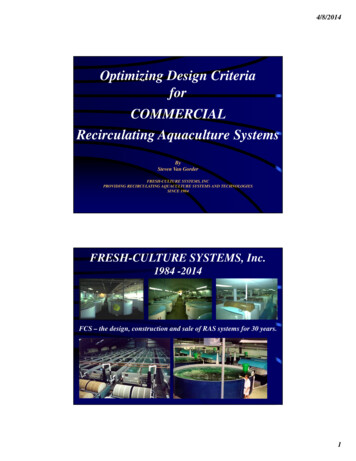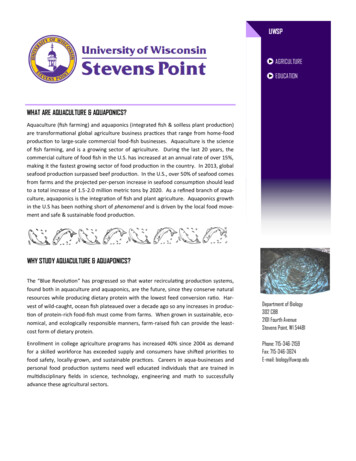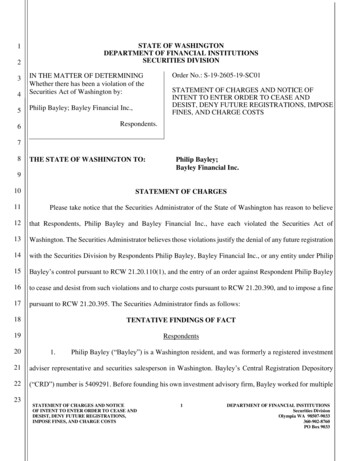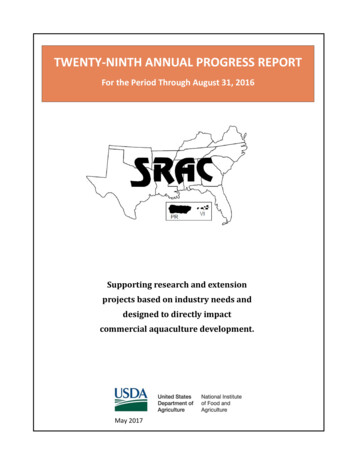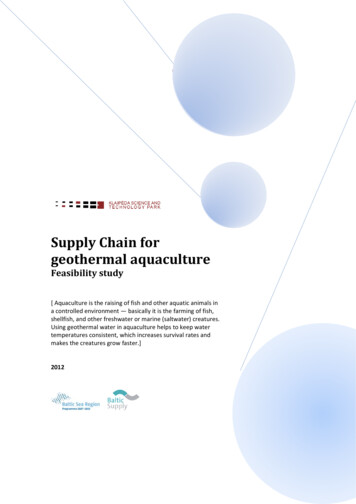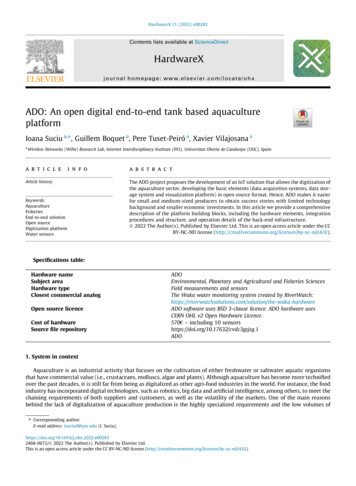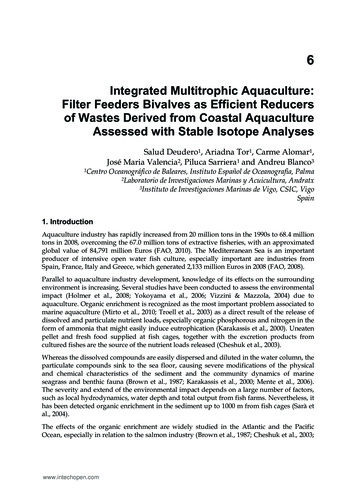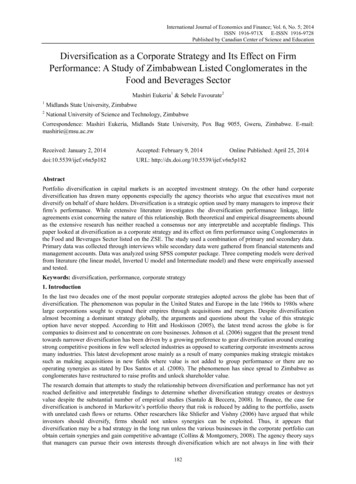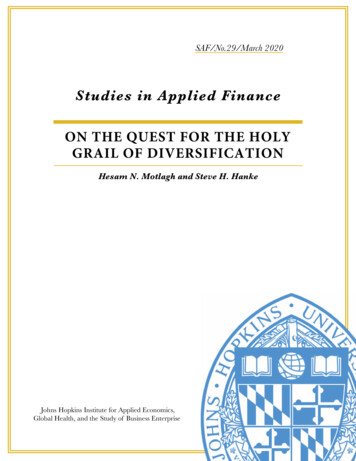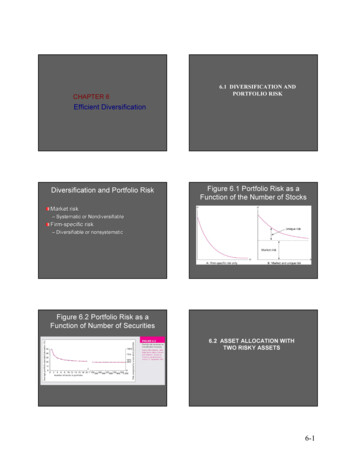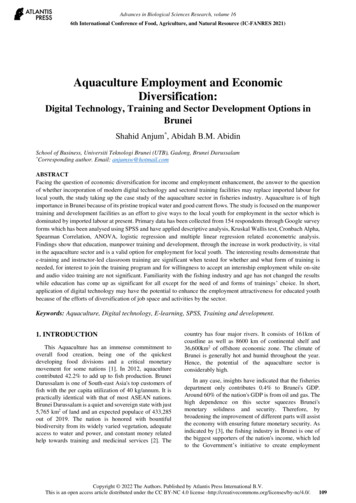
Transcription
Advances in Biological Sciences Research, volume 166th International Conference of Food, Agriculture, and Natural Resource (IC-FANRES 2021)Aquaculture Employment and EconomicDiversification:Digital Technology, Training and Sector Development Options inBruneiShahid Anjum*, Abidah B.M. AbidinSchool of Business, Universiti Teknologi Brunei (UTB), Gadong, Brunei Darussalam*Corresponding author. Email: anjumsw@hotmail.comABSTRACTFacing the question of economic diversification for income and employment enhancement, the answer to the questionof whether incorporation of modern digital technology and sectoral training facilities may replace imported labour forlocal youth, the study taking up the case study of the aquaculture sector in fisheries industry. Aquaculture is of highimportance in Brunei because of its pristine tropical water and good current flows. The study is focused on the manpowertraining and development facilities as an effort to give ways to the local youth for employment in the sector which isdominated by imported labour at present. Primary data has been collected from 154 respondents through Google surveyforms which has been analysed using SPSS and have applied descriptive analysis, Kruskal Wallis test, Cronbach Alpha,Spearman Correlation, ANOVA, logistic regression and multiple linear regression related econometric analysis.Findings show that education, manpower training and development, through the increase in work productivity, is vitalin the aquaculture sector and is a valid option for employment for local youth. The interesting results demonstrate thate-training and instructor-led classroom training are significant when tested for whether and what form of training isneeded, for interest to join the training program and for willingness to accept an internship employment while on-siteand audio video training are not significant. Familiarity with the fishing industry and age has not changed the resultswhile education has come up as significant for all except for the need of and forms of trainings’ choice. In short,application of digital technology may have the potential to enhance the employment attractiveness for educated youthbecause of the efforts of diversification of job space and activities by the sector.Keywords: Aquaculture, Digital technology, E-learning, SPSS, Training and development.1. INTRODUCTIONThis Aquaculture has an immense commitment tooverall food creation, being one of the quickestdeveloping food divisions and a critical monetarymovement for some nations [1]. In 2012, aquaculturecontributed 42.2% to add up to fish production. BruneiDarussalam is one of South-east Asia's top customers offish with the per capita utilization of 40 kg/annum. It ispractically identical with that of most ASEAN nations.Brunei Darussalam is a quiet and sovereign state with just5,765 km2 of land and an expected populace of 433,285out of 2019. The nation is honored with bountifulbiodiversity from its widely varied vegetation, adequateaccess to water and power, and constant money relatedhelp towards training and medicinal services [2]. Thecountry has four major rivers. It consists of 161km ofcoastline as well as 8600 km of continental shelf and36,600km2 of offshore economic zone. The climate ofBrunei is generally hot and humid throughout the year.Hence, the potential of the aquaculture sector isconsiderably high.In any case, insights have indicated that the fisheriesdepartment only contributes 0.4% to Brunei's GDP.Around 60% of the nation's GDP is from oil and gas. Thehigh dependence on this sector squeezes Brunei'smonetary solidness and security. Therefore, bybroadening the improvement of different parts will assistthe economy with ensuring future monetary security. Asindicated by [3], the fishing industry in Brunei is one ofthe biggest supporters of the nation's income, which ledto the Government’s initiative to create employmentCopyright 2022 The Authors. Published by Atlantis Press International B.V.This is an open access article distributed under the CC BY-NC 4.0 license 9
Advances in Biological Sciences Research, volume 16opportunities and increase the GDP of the country bylaunching a 5-year strategy plan, Strategic Plan 20162020 in 2017. The Ministry of Primary Resources andTourism (MPRT) aims to create employment for locals,particularly in other sectors such as forestry, agriculturaland aquaculture among the youth by the launching of theStrategic Plan. It also predicts to generate 2,500 new jobsto meet the desired target.In the present current innovation, e-Learning or eTraining makes a quicker route in spreading logical dataand information on agribusiness and aquaculture toranchers and different partners [4]. As per [3] advancedinnovation is probably the quickest method ofcorrespondence mechanical developments that promptede-Learning modules that can be conveyed through cellphones, short video movies, databases and web-basedinterfaces. Instruction assists with improving andincrementing aquaculture commercial centre’s workprofitability, utilizing the abilities of aquaculture staff. ELearning is a suitable technique that can be made open toanybody as it permits them to work and studysimultaneously [5-6].2. DATA DESCRIPTION ANDMETHODOLOGYThe primary data was collected between April andMay 2020 and obtained from a comprehensivequestionnaire to gather quantitative data related toaquaculture as per the subject matter, primarily focusingon training methods, and farm-specific information suchas activities, local engagement, training methods andimprovements. A 6-points Likert scale (6-LS) has beenused in the survey which measured each index rangingfrom strongly agree to strongly disagree (1-6,respectively) [7]. Asian ethnic tend to choose the middlescore or non-partisan for their responses. Hence, thechoice of the 6-points Likert scale was sensible. A samplesize of 154 had been gathered and collected from GoogleForm and the results have been converted to MS Excelfile. The questionnaire is then evaluated by using SPSSto compute the data and analyse their significance. Thetarget group for this data research is mostly students(youth).2.1. DemographicsThe questionnaire has a demographic sectionconsisting of questions about gender (GEN), age (AGE)and highest level of education (EDU). There is acheckbox type question, with yes and no option, relatedto 10 different categories of activities involved inproduction methods of Aquaculture and fishing industrynamed as Activities (ACTi) which are feeding andfertilizing (A1), harvesting (A2), processing andmarketing (A3), farm preparation (A4), maintenance(A5), fish stocking (A6), security (A7), experimentalbreeding (A8), technician (A9) and fish grading (A10).2.2. Descriptive AnalysisThree categories from the survey have been selectedto run the descriptive analysis, named as ‘preferredtraining methods’ (TMi), ‘preferred working hours’(WRKi) and ‘preferred organizational aspects’ (ORGi).TMi has 4 sub-categorical variables, which areinteractive method hands on training (TM1), instructorled classroom training (TM2), computer based and elearning training (TM3) and visual audio training (TM4).WRKi has 5 sub-categorical variables, namely, full timework schedule (WRK1), part time work schedule(WRK2), fixed work schedule (WRK3), flexible workschedule (WRK4) and rotating shift work schedule(WRK5). Lastly, ORGi has 7-sub categorical variablesand they are quality (ORG1), appearance (ORG2),management (ORG3), commute distance (ORG4), salary(ORG5), flexibility (ORG6) and career stability (ORG7).All these sub-categorical variables are obtained by 6point Likert scale (6-LS) which range from stronglyagree, moderately agree, slightly agree, slightly disagree,moderately disagree to strongly disagree.2.3. Methods of Data AnalysisThis study has employed two types of data analysishave been applied in this study, namely statisticalanalysis and econometric analysis using SPSS version22. The tests that have been carried out in the statisticalanalysis include Cronbach’s Alpha, ANOVA, KruskalWallis, logistic regression, and Kolmogorov Smirnovand Shapiro Wilk. Whereas, for the econometric analysis,multiple linear regression models has been used toanalyse the data. The selection of these techniques havebeen made after reviewing vast variety of techniquesfrom literature including stepwise linear functiontechnique [5], logistic regression [8-9], variables rankingmethodologies [10-13], mathematical rationale forregulatory variables [14], multi-criteria decision makingmethodologies [15], advanced econometric analysis [6,16] data mining based logic [17-18] and fuzzy basedmulti-criteria decision making methodologies [15, 19]Cronbach’s alpha is used to measure reliability. Areliability coefficient of .70 or higher is consideredacceptable and a high level for alpha means that items inthe test are highly correlated [20]. The result ofCronbach’s alpha in this study is 0.747. The value isconsidered to be a good reliability value. Normality testis an important factor when executing a data.Kolmogorov-Smirnov and Shapiro Wilk are used to testnormality. The result was analysed using a descriptiveanalysis and the observation of significant values for allp-values are p 0.01. A p‐value less than 0.01 (p 0.01)110
Advances in Biological Sciences Research, volume 16signifies a non-normal distribution (J, 2005). Hence, anon-parametric test is being used in this study.2.3.1. ANOVA and Kruskal WallisIn this study, ANOVA and Kruskal Wallis have beentested to compare their significance. However, in caseswhere these pre-test criteria are not fulfilled for theANOVA, the Kruskal Wallis test is the better alternative.The Kruskal–Wallis is used as a nonparametric tocompare the means of multiple groups. Four mainquestions, they are as follows; I am interested to join atraining program in the fishing industry? (ENG1); I amwilling to accept an internship employment? (ENG2); Iam familiar with the fishing industry in Brunei (FAM);and I think training is needed in the fishing industry(TR1) have been chosen to run and compare both testwith selected variables such as AGE, GEN, TMi, WRKiand ORGi. Respondents have been asked to answer eachindex from strongly agree to strongly disagree (1-6,respectively).to foresee and explain the correlation between onedependent variable and two or more independentvariables. Two MLR data set have been executed, one setis the MLR full set (MLRFS) with FS representing fullset of variables used in the regression. The other set is theMLR removed variables (MLRRV) where RV means thatsome insignificant variables have been removed from theregression. MLRFS means the regression has been testedand run using all the initial independent variables againstthe outcome. Once the test has been run, the results thathad obtained no significant values have been eliminated.From there, the MLR is then run and tested for the secondtime, excluding the insignificant p-values that wereobtained initially. The results of the new MLR set iscalled the, MLRRV which have been executed and run toobtain a better significant result. Those missing valuesfrom the MLRRV have been labelled as RV, whichmeans the insignificant variable has been removed. Thefollowing section reports the results of the analysis whichhave been mentioned in this section.3. RESULTS AND DISCUSSION2.3.2. Logistic Regression3.1. Demographic ResultsLogistic regression analysis has been used in thisstudy to find the relationship between 10 sub categoriesof ACTi (A1, A2, A3, A4, A5, A6, A7, A8, A9 and A10)where it has been obtained using a checkbox with a ‘Yes’or ‘No’ option and three of independent categoricalvariables, name as TMi, WRKi and ORGi. Logisticregression is the right technique to be used as a predictiveanalysis where, given the values of independentvariables, predictions of dependent variables areestablished through the cumulative standard logisticdistribution function [21]. Moreover, logistic regressionis the appropriate regression analysis when the dependentvariable is dichotomous (binary) and it is used to describedata and to explain the relationship between onedependent binary variable and one or more nominal,ordinal, interval or ratio-level independent variables [22].The demographic variables obtained are presented inTable 1. Three dependent variables namely, GEN, AGEand EDU have been used to show the demographicresults of the 154 respondents obtained from the survey.GEN came up with two categories i.e. females (F) andmales (M). EDU has the categories like O-level andbelow (O-L), A level or National Diploma (ND), HigherNational Diploma holder (HnD), Bachelor’s degree(BCH), Master’s degree (MST) and Ph. D. degree (PHD).AGE comprises the choices of below 18 years old (B18),18-25 years old, 26-55 years old and above 56 years oldcategories.2.3.3. Econometric AnalysisA few investigations recommended by utilizingeconometric model, the connection among dependentand independent variables have a basic method to makeimperative data. There are various regression approacheswhich may be an option like the use of ordinary leastsquare on survey data [23]. Bank risk scores are regressedagainst operating efficiency measures [16] as well as inanother usage of a variant regression approach toestablish the ranks of banks has been used in [12, 15].Variables calculated using stochastic frontier approachhave been used in regression in order to understand therelationship between inefficiency scores and the numberof ATMs [21]. Multiple linear regression (MLR) modelhas been used to analyse this study. MLR is used as a toolTable 1. Descriptive Stat of respondentsVar CatsFreqVariable GENM81F73Variable AGEB18518-2593%52.647.4Var CatsFreqVariable 334.4MST1711A5631.9PhD16Note: Var Cats Variable CategoriesIn table 1, the gender of the respondents for thissurvey have been extracted from 154 respondents.Frequency (Freq.) of females is 47.4% and of males is52.6% of the total sample respondents. The highestaverage age group is between 18-25 years old with 60.4%and a total number of 93 people, followed by the agegroup of 26-55years old with 33.4% and a total of 53111
Advances in Biological Sciences Research, volume 16people. This study indicates that most of the interestedGrown-ups with more elevated levels of education areparties are found in the youth group. In addition to that,commonly bound to take an interest in the work power.59.09% of the respondents held a Bachelor’s Degree.Table 2. Drop-out analysis for ‘preferred training methods’ (TMi), ‘preferred working hours’ (WRKi) and ‘preferredorganizational aspects’ orkingHoursPreferredOrganizationalAspectSub CategoriesHands on TrainingInstructor Led Classroom TrainingComputer Based and E-learning TrainingVisual Audio TrainingFull Time Work SchedulePart Time Work ScheduleFixed Work ScheduleFlexible Work ScheduleRotating Shift Work ScheduleQualityAppearanceManagementCommute DistanceSalaryFlexibilityCareer StabilityThe outcome is likewise being upheld by [17], whohas expressed that sexual orientation and age inaquaculture have gotten expanding consideration. Sincea greater part of the age group are from 18-25 years ofage (youth), the outcome proposes that a professionalframework and the use of innovative courses add to thecapability of youngsters in fishing networks ought to beexecuted [26]. This will diversify the employmentoptions for youth. Bruneians are familiar with the fishingindustry in relation to the age group and highest level ofeducation.3.2. Statistical Descriptive ResultsA descriptive analysis has been run to find the resultsof three sets of categories, TMi, WRKi and ORGi (Table2). All the results from these 3 sets of categories arepresented in table 2, 3 and 4 accordingly. Results from154 respondents in regards to TMi showed that 100% ofthe respondents agreed to TM1, followed by TM2 with apercentage of 95.5%, then TM4 with a percentage of88.4% and TM3 came last, with a total of 80%. The resultindicates that TM1 showed the most preferred effectivemethod of training when working in the aquaculturesector.Larger part of the individuals despite everythingincline toward up close and personal and hands-ontraining [24]. Notwithstanding that E-Learning or eTraining strategy is another more prominent approach tooverhaul instructive frameworks in decreasing theinstructive hole among provincial and urban zones, andin giving expanded and equivalent investigation 40.028.432.327.728.429.021.937.436.830.331.63-LS (%)342.6021.9 3.243.9 11.034.2 6.527.1 9.031.0 6.526.5 11.021.3 10.323.2 11.63.90.05.20.03.90.625.8 5.813.5 2.614.8 0.0doors for country individuals and individuals withoverwhelming timetable [7]. Aquaculture is said to be aglobal activity where e-Learning can be applied toperform a rapid and efficient result in terms of teaching,learning and training [24]. Therefore, usage of eLearning or e-Training in the aquaculture segment canpermit individuals to work and study simultaneouslyabsent a lot of confusion.For WRK1, all the ‘agreed’ responses have beensummed up to make it easier to interpret the results and itshowed that WRK2 has the highest percentage of 88.4%,followed by WRK3 with a total of 83%, then WRK1 andWRK4 that have the same percentage of 81.3% and lastlyWRK5 with a total percentage of 72.7%. Working hoursof a company or industry are considered, one of the mostimportant factors when working.Results of organization aspects have been obtainedfrom 154 respondents with 7 sub-categories to choosefrom (ORGi) indicated that 72.9% of the respondentshave strongly agreed in management of the organization(ORG3) as the most important factor to them whenworking in a company or industry. Followed by, OR1with a percentage of 67.1%, 65.2% for ORG2, 59.4%ORG7 and 45.8% for ORG5 (respectively).3.3. ANOVA and Kruskal Wallis ResultsANOVA (F-test) and Kruskal Wallis (KW) have beenrun in this analyse for both p-values obtained and thencompared. A total sample size of 154 has been tested, anddivided into 4 groups (ENG1, ENG2, FAM and TR1)respectively and 18 selected variables have been112
Advances in Biological Sciences Research, volume 16significantly chosen to run analyse for both test anddivided into three groups with 6 selected significantvariables: AGE, EDU, TM1, TM2, TM3 and TM4 (Table3). Whilst, in table 4 only TR1 has been selected with 16significant variables (TM1-TM4, WH1-WH5 andORG1-ORG6).Table 3. ANOVA and Krusal Wallis results for ENG1, ENG2 and FAM as dependent .011(**) (***)F,pENG1 0.38 0.361 .056(*) .045(*)ENG2 0.299 0.401(***)(***)FAM(***) (***) .092(*) 0.172Significance: p-value at: * 0.1, ** 0.05, *** 0.01As can be seen from table 3, when comparing ENG1and ENG2 with EDU, both of the outcomes showedsimilar level of significance in both tests. Similar resultshave been obtained in TM2 and TM4. However, forENG2, the TM1 and TM3 presented differences in theirlevel of significance. TM1 obtained a significant valueof, p 0.05** for the F-test and p 0.01*** for the KWtest. Whereas, for TM3 case, a p-value of 0.05** hasbeen obtained in the F-test and p- value of 0.1* in theKW-test [25].Kruskal Wallis test showed a better significant resultin the TM1. However, in TM3, a better significant valuehas been obtained using ANOVA test. ANOVA test hasalso performed better for FAM when EDU was selectedas their significant variable, while KW showed nosignificance at all. In Table 4, 16 selected variables havebeen chosen to run with TR1. The outcome for KW-testhas obtained better results of significance whencompared to F-test. The ANOVA test only presented 2significant results for TM3 and TM4 of which the KWtest could not obtain.Table 4. ANOVA & Kruskal Wallis Results for DV **ORG70.906***Significance: p-value at: * 0.1, ** 0.05, *** .771.055(*)A total of 11 out of 16 variables have obtainedsignificance using the KW test. To summarize thefollowing, since both of the test depend on two importantfactors; sample size and normality. Survey questionnaireis not normally distributed. However, in theory, a samplesize of more than 30 is assumed to be normallydistributed data, which assumes ANOVA test is morepreferred as it is more powerful than Kruskal Wallis.Kruskal Wallis is a non-parametric test as it does notmeet normality, while ANOVA meets normality. In thiscase, a normality test has been run using KolmogorovSmirnov and Shapiro Wilk. The result has been analyzedand it signifies a non-normal distribution, hence a nonparametric test should be used. Therefore, the KruskalWallis test is the preferred in this study.3.4. Logistic Regression ResultsThe ACTi set of variables have been converted into aquantitative variable using binary transformation.activities as a dependent variable has been run against allthe independent variables of each of the three categories(TMi, WRKi and ORGi) separately. The results have beenassessed for all 160 coefficients from a total of 30 logisticregressions and have found that unfortunately, there areonly few statistically significant coefficients.For ACTi as DV, vis-à-vis TMi set of variables as IV,there are only 3 out of 40 coefficients that have beenfound as significant. Whereas, ACTi as DV, vis-à-visWRKi set of variables as IV, showed only 10 out of 50coefficients have been statistically significant. For thelast regression only 2 out of 70 coefficients have beensignificant, where ACTi as DV, vis-à-vis ORGi set ofvariables as IV. Since, the number of results for thesignificant values are minimal, logistic regressionanalysis would not be as effective and reliable to predictthe outcome. Hence, multiple linear regression is thentested and used to get a better result of the analysis.3.5. Econometric ResultsTwo MLR dataset have been run using this analysis,namely MLRFS and MLRRV. In the MLRRV dataset, four113
Advances in Biological Sciences Research, volume 16categories (FAM, TR1, ENG1 and ENG2) have beenselected as the DVs, and twelve as the IVs. The completemultiple regressions have been provided in the Table 5.However, there are only few significant relationships inTable 5. The complete results of multiple regressionsMultiple regressions a results for TR1, ENG1 & ENG2DV (Cols) /TR1ENG1ENG2IV 0.008CONST.1.026***1.653**2.064***R2 / F0.378***0.111***0.120***Multiple regression b results for TR1, FAM & ENG2DV (Cols) /TR1FAMENG2IV **-0.018CONST.1.604***3.898***2.796***R2 / F0.0940.1440.38various multiple regressions with only few starsappearing in front of various independent variables forshowing significance of variables.Multiple regression c results for TR1, ENG1 & ENG2DV (Cols) /TR1ENG1ENG2IV 9**0.1770.182CONST.0.827***2.431***1.876***R2 / F0.478***0.0480.77Multiple regression d results for TM1 – TM4DV (Cols) /TM1TM2TM3IV .279***1.48***2.094***R2 / icance: p-value at: * 0.1, ** 0.05, *** 0.01Therefore, selected independent variables in theMLRRV dataset i.e. AGE, EDU, TMi, ENG1i, ENG2i,WRKi, and ORGi have been chosen for final regressionswhich have been described in Tables 6 and 7.Table 6. Multiple Regression 1 results for TR1DVTR1TR1MLRFSRVIV (Below)AGE-0.085RVEDU-0.013RVTM10.2410.134TM20.190 (***)0.137 (***)TM30.035RVWRK40.079 (**)0.060 (*)WRK50.704 (***)-0.055 (*)ORG10.196 (*)0.134ORG40.108 (*)0.074ORG60.165 (**)-0.183 (***)ORG70.189 (**)0.162 (**)Const1.604 (***)0.758 (***)R2 / F0.0940.233 / (***)Significance: p-value at: * 0.1, ** 0.05, *** 0.01It is seen that none of the correlations coefficients arehigher than .80 in these tables 8a and 8b. In the FAMcategory, there are 4 selected independent variablesnamed AGE, EDU, ENG1 and ENG2. ENG1 and ENG2have been removed in the MLRRV column because oftheir insignificant values. The result can be interpreted insuch a way, 1% change in AGE will bring in 0.79%decrease in FAM and a 1% change in EDU will give0.25% increase in FAM. Out of the twenty variables, twoof them such as: AGE and EDU significantly affect theFAM in this study.Table 7. Multiple Regression results for 4 sets ofcategories on selected significant variables (***)4.16(***)114
Advances in Biological Sciences Research, volume 16R2 / F0.1440.09Local young people must be energized and proactive(***) in the aquaculture sector as Brunei is honoured withSignificance: p-value at: * 0.1, ** 0.05, *** 0.01immaculate tropical water and a great momentum stream.Not exclusively will this decrease the effectively highunemployment rate in Brunei, it can likewise add to theexpansion in personal satisfaction and number ofexceptionally gifted educated local people. The exampleof overcoming adversity of most aquacultureimprovement generally relies upon exceptionally verymuch prepared experts [26]. Henceforth, the outcomesproposed that aquaculture in Brunei ought to be featuredby executing training programs, aquaculture coursesmade accessible in school or higher institutions toimprove Brunei's aquaculture sector.0.11(***)0.092(***)0.120(***)0.1(***)The R2 value in FAM represents how muchpercentage is explained by the equation. The regressionin this study showed that only 7.7% of FAM (DV) isexplained in the 2 IVs (AGE and EDU). Hence, thespecification of the hypothesized model is not very good.However, both AGE and EDU significantly contributedto the model. As for TR1, 11 selected IVs (AGE, EDU,TM1, TM2, TM3, WRK4, WRK5, ORG1, ORG4,ORG6, and ORG7) have been run in this regressionmodel and it resulted in removing 3 IVs (AGE, EDU andTM3) because of their insignificant values. TM2, WRK4,WRK5, ORG6 and ORG7 significantly contributed to themodel. However, TM1, ORG1 and ORG4 did not.Eight variables have been run with TR1 as their DV.One of the results from the TR1 suggested that 1%change in TM2 will provide 0.14% increase in TR1 andthe R2 value is 0.190. The representation of this resultshowed that only 19% of the relationship of TR1 has beenexplained by those 8 IVs. Looking at these coefficients,it may be said that the model did not predict thedependent variable very well. Kwiatkowski–Phillips–Schmidt–Shin (KPSS) is based on linear regression. Theregression equation has been obtained as it is shownbelow:KPSS 0.758 0.134TM1 0.137TM2 0.060WRK4 0.055WRK5 0.134ORG4 0.074ORG4 - 0.183ORG6 0.162ORG7A multiple regression has been carried out toinvestigate whether the five independent variables (AGE,EDU, TM1, TM2 and TM3) could significantly predictENG1 and ENG2 results. The results in ENG1 and ENG2indicated that the model explained 9.2% and 9.7%,respectively of the variance and that both models havebeen significant predictors with p 0.01***. In otherwords, 1% change in EDU will provide 0.16% increasein ENG2, whilst in ENG1, will only give 0.18% increase.The differences between these two are very small.However, the coefficient results determined that themodel did not predict the dependent variable very well.3.6. DiscussionThe industry presently has not taken care of the issuesthat are discovered, for example, absence of sufficientfield offices, experienced educators, and very muchplanned educational plans for training. Appropriatelabour is desperately expected to oversee and continuethat development. The fundamental issue in theaquaculture segment is that local people are moderatelyless talented to perform pertinent undertakings becauseof deficient information and training. One approach toimprove is to utilize inventive education with e-Learning,since 94.87% of Bruneians approach the web [26].4. CONCLUSIONThis study has empirically examined whether localmanpower training and development using digitaltechnology (e-learning) in the aquaculture sector can helpto diversify the employment options for youth in Brunei.It is concluded that manpower training and developmentis important to improve the quality of the industry. Usinga sample of 154 respondents, the study finds about 93youths (60.4% of the sample observations) are interestedto perform a rapid and efficient result in terms ofteaching, learning and training in the aquaculture sector.In spite of the fact that Brunei Darussalam marine fishaquaculture is still small-scale, it however showed abright promising trend towards expansion and progress.This sector will enable the nation to broaden its economyand decrease its unemployment rate and dependence onimportation of food, while giving food securityaffirmation for Brunei. In this manner, aquaculture issupposed to be a worldwide movement where e-Learni
non-parametric test is being used in this study. 2.3.1. ANOVA and Kruskal Wallis In this study, ANOVA and Kruskal Wallis have been tested to compare their significance. However, in cases where these pre-test criteria are not fulfilled for the ANOVA, the Kruskal Wallis test is the better alternative.
